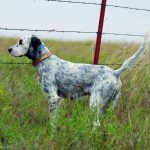Dog Influenza
by Dave Erlewein, D.V.M.
The flu is certainly in the forefront of the news the past few months, especially the H1N1 virus affecting humans. While human, avian, swine, and equine flu viruses are common, dogs have been considered exempt from the flu – until recently. In fact, you’ve probably heard many times that “dogs don’t get the flu.” In 2004, however, a canine specific type A influenza virus capable of causing disease appeared in racing greyhounds at tracks in Florida. Since then, the virus has appeared in at least 30 states and is considered an endemic, or very prevalent, in areas of Florida, Pennsylvania, New York, and Colorado. In addition to dog tracks, outbreaks of the disease have occurred in other places where dogs congregate, such as boarding facilities, animal shelters, doggie day care centers, and veterinary hospitals.
There are three types of influenza viruses: type A, type B, and type C. The various sub-types of each virus are named based on the amino acids that make up the hemaglutinin (H) and neuramidase (N) glycoproteins on the outer layers of the virus. Thus, the type A human virus causing all the recent concern is named H1N1, and the newly evolved type A canine influenza virus (CIV) is named H3N8
The appearance of CIV represents a fairly rare event in the evolution of viruses. In some fashion, the entire genetic makeup of a horse H3N8 influenza virus was transferred to dogs, and the virus adapted to become a unique, dog specific virus. Currently, this virus is not known to infect humans or any other species. Because this is a newly emergent virus, all dogs, regardless of age are considered susceptible and have no natural immunity.
CIV is spread in three ways: Direct contact with respiratory secretions of infected dogs, contaminated objects such as bowls, toys, etc., and by people handling infected dogs and uninfected dogs. The virus remains alive and capable of causing infection on surfaces for up to two days, clothing for nearly a day, and the hands of the owners up to 12 hours. Dog owners whose dogs are coughing or showing other signs of respiratory infections, such as a runny nose, should not take their dogs to kennels, grooming parlors, training facilities, or doggie day care centers. In addition, the owners themselves should not be in direct contact with uninfected dogs.
The primary symptoms of CIV are fever, lethargy, cough, and runny nose. Around 75-85 percent of the infections are mild; somewhere around 20 percent of infected dogs will form antibodies to the virus and recover without showing any signs of disease. However, these dogs do shed the virus and may serve as a source of infection for other dogs.
After infection, it takes up to five days for the first signs of illness to appear. Unfortunately, during this period the shedding of the virus is at its peak and dogs are most contagious when they are not showing any signs! Shedding of the virus decreases rapidly in the first few days of illness but may last for up to two weeks. Coughing may last anywhere from two to four weeks.
The CIV virus infects and multiplies in the cells of the respiratory tract, specifically, the nose, trachea, the bronchi, and the smaller airways of the lungs. Inflammation in these areas causes the signs of nasal discharge, fever, and cough. In addition, many of the cells lining the respiratory tract actually die and allow secondary bacterial infections to develop. It is the secondary bacterial infections that cause severe illness, pneumonia, and rarely, death.
Treatment of dogs with CIV may include cough suppressants, antibiotics when secondary bacterial infection is present, and fluid therapy when dehydration is evident. Drugs to reduce fever are frequently employed. The use of human antiviral drugs is not currently recommended.
Home care involves isolation from other dogs for at least two weeks, good nutrition, and hydration. Disinfect all feeding utensils, toys, kennels, etc. If possible, slightly increase the humidity as drying of the mucous membranes of the respiratory tract may prolong illness.
In May of 2009, a vaccine for the prevention of CIV became available. This vaccine is a killed virus product. Just like human flu vaccines, it may not prevent infection altogether, but it will decrease the severity and duration of illness. In addition, the vaccine decreases both the amount of virus shed and the period when shedding occurs.
The CIV vaccine is not advised for all dogs. My current recommendation is that if you live in or visit one of areas where the disease is considered endemic and you board your dog or frequently visit areas where there are lots of dogs, you should get the vaccine. Some dog owners may feel more comfortable getting the vaccine if they routinely board their dog or visit training facilities, dog parks, grooming parlors, or other areas where dogs congregate even if they do not live in an endemic area. Vaccination for kennel cough (Bordetella) and canine parainfluenza (commonly found in annual or triennial DHPP vaccines) will not protect against CIV.
The most important thing to remember is that if your dog is coughing or showing any other signs of respiratory infection, consult your veterinarian. You should never take a coughing dog to a grooming parlor, kennel, dog park, doggie day care center, or any other dog gathering area without first consulting your veterinarian.





